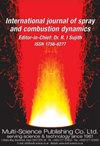钝体辅助声波双流体雾化器的雾化特性
IF 2.1
4区 工程技术
Q3 ENGINEERING, MECHANICAL
International Journal of Spray and Combustion Dynamics
Pub Date : 2022-05-30
DOI:10.1177/17568277221104924
引用次数: 1
摘要
本研究考察了基于锥距(Lc)为6.0的三种不同几何形状的声波钝体辅助双流体雾化器的气体动力学效应和雾化行为 毫米,8.0 mm和10.0 这些采用280 基于一定范围的空气和液体流速,对具有中心钝体(圆锥体)的µm环形液体片进行了比较。通过体积归一化液滴尺寸分布(DSD)和累积液滴分布、偏心图、Sauter平均直径(SMD)和相对跨度因子(Δ)来表征喷雾钝体对二次雾化的影响。当为给定的液体流速绘制时,随着气流速率的增加,DSD和累积液滴分布变得更加均匀,与锥体距离(Lc)无关。偏心图在喷雾中心线处显示出高偏心液滴,在偏离中心的喷雾位置处显示出大部分接近球形的液滴。SMD和RSF(Δ)分别随着SMD的增加和RSF的减小而与空气-液体比(ALR)呈相反的趋势。当绘制所有径向位置时,Sauter平均直径(D32)和相对跨度因子(Δ)显示了团簇的形成。较大的SMD值对应较低的RSF(Δ)值,反之亦然。本文章由计算机程序翻译,如有差异,请以英文原文为准。
Atomization characteristics of a bluff body-assisted sonic twin-fluid atomizer
This study examines the gas dynamic effect and atomization behaviour of the sonic bluff body-assisted twin-fluid atomizer with three distinct geometry configurations based on cone distances (Lc) as 6.0 mm, 8.0 mm, and 10.0 mm. The atomization characteristics of these atomizers employing a 280 µm annular liquid sheet with a central bluff body (cone) are compared based on a range of air and liquid flow rates. The spray-bluff body impacted secondary atomization was characterized through volume-normalized droplet size distribution (DSD) & cumulative droplet distribution, excentricity plots, Sauter mean diameter (SMD), and relative span factor (Δ). When plotted for a given liquid flow rate, the DSD & cumulative droplet distribution becomes more uniform with the increase in the airflow rate independent of the cone distance (Lc). Excentricity plots exhibited high excentricity droplets at the spray centreline and a large fraction of nearly spherical droplets at off-centre spray locations. SMD and RSF (Δ) showed opposite trends when plotted against the air-to-liquid ratio (ALR) as SMD increases while RSF decreases with radial locations, respectively. When plotted for all radial locations, Sauter mean diameter (D32) and relative span factor (Δ) show a cluster formation. Larger SMD values correspond to lower RSF (Δ) values and vice-versa.
求助全文
通过发布文献求助,成功后即可免费获取论文全文。
去求助
来源期刊

International Journal of Spray and Combustion Dynamics
THERMODYNAMICS-ENGINEERING, MECHANICAL
CiteScore
2.20
自引率
12.50%
发文量
21
审稿时长
>12 weeks
期刊介绍:
International Journal of Spray and Combustion Dynamics is a peer-reviewed open access journal on fundamental and applied research in combustion and spray dynamics. Fundamental topics include advances in understanding unsteady combustion, combustion instability and noise, flame-acoustic interaction and its active and passive control, duct acoustics...
 求助内容:
求助内容: 应助结果提醒方式:
应助结果提醒方式:


